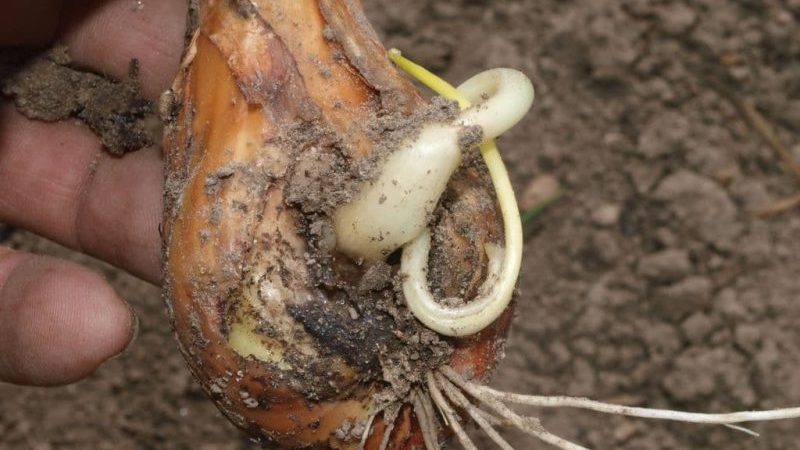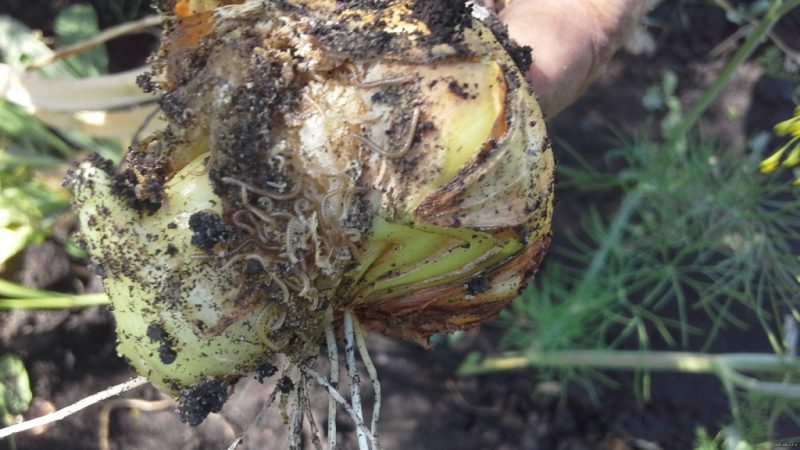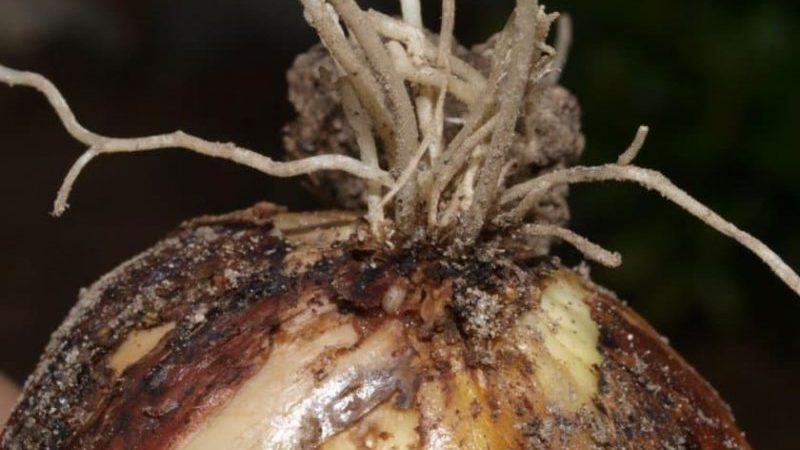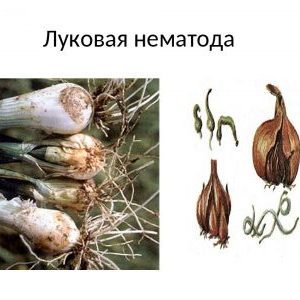What type of worm is the onion nematode, and how to deal with it
Nematoda is a dangerous pest that inhibits the development of plants and leads to their death. This tiny worm causes great damage to both private gardens and large farms.
Onion nematode causes rotting of onion heads, death of the root system and stems. Contaminated crops become unfit for human consumption. From the article you will learn what the onion and garlic stem nematode is and how to deal with it.
The content of the article
What is an onion nematode?
Nematoda damages not only onion beds. This pest is dangerous for parsley, tomato, radish. How to recognize it?
Description and characteristics

The onion-garlic nematode is a white filamentous worm. The length of the pest is 1-1.5 mm and the thickness is 0.05 mm.
In the front part of the body there is a sharp needle-shaped organ with which the nematode sucks out the cellular juices of plants. The back of the body is pointed. Females are larger than males.
The larvae differ from sexually mature individuals by an inferior reproductive system and miniature size - only 0.3 mm in length. The eggs of the parasite are tiny at all - 70 × 30 microns.
Attention. On dry onion scales, the parasite remains viable for more than two years, and in dried infected garlic - up to five years.
The worm hibernates in bulbous heads and chives, as well as in soil and in seed. Distributed everywhere. In Russia, it is found mainly in heavy soils.
Features:
What type of worm is the nematode? The pest is an extensive family of parasitic roundworms. Recently, there have been discussions about the species belonging of the worm. Formerly onion stem nematode and potatowere ranked as one species. However, then scientists found out that the food objects of these parasites are different, which causes some physiological differences.
Soil-dwelling nematodes patiently wait for the host plant to appear. They can go without a food source for up to 18 months. In search of food, the worms rise from a depth of 1.5 m. Adults infect stems, leaves and bulbs.
Important. A massive invasion leads to the destruction of the part of the plant in which the parasites have settled. Then they leave the dead tissue and move to the next plant.
The pest is distinguished by its amazing vitality. Eggs and larvae of nematodes are able to withstand temperatures down to -80 ° C for 20 minutes. Therefore, frosty winters have little effect on the number of pests living in the soil.
With a decrease in humidity, the worms fall into suspended animation, in which they can stay for up to 20 years.
Breeding period

Reproduction of the onion nematode takes place inside the leaves and bulbs by laying eggs. Larvae emerge from the eggs, passing through four stages in their development.
The life cycle of the parasite takes about 45 days. Thus, during one gardening season, three or four generations have time to grow.
Thousands of individuals settle on one plant at the same time. Sexually mature individuals mate directly in the host plant. Each female lays up to 400 eggs (8-10 eggs per day).
The optimum temperature for the reproduction of the parasite is + 13 ... + 18 ° С. But even in the range from + 1 ° С to + 35 ° С, reproduction of worms does not stop.
The larvae emerge from the eggs after a few days.Young individuals begin to actively feed, devouring plant tissues. The grown larvae are able to move to neighboring plants.
Food habits
The nematode pierces the tissues of the plant with its stylet - a pointed organ in the front of the body - and sucks out cellular juices. The parasite's enzymes, secreted during feeding, inhibit the development of greens and onion heads.
After some time, the plant most densely populated with parasites dies. And nematodes, sensitive to the quality of nutrition, leave dead tissue and move to neighboring plants.
Symptoms of an onion nematode infection
Infection is evidenced by symptoms such as underdevelopment and deformation of the leaves, their yellowing and drying, loosening of the bulb, its cracking. The bottom becomes rotten, falls off, and the bulb is completely destroyed.
In an onion that has undergone early nematode infestation, the first leaf that appears is curved and swollen; later, as it grows, the curvature of the leaves and thickening, located mainly in their lower parts, become more and more noticeable.
If the seedlings were infected at a later stage of development, diseased plants may not differ much from healthy ones, but white spots often appear on the bulbs.
By cutting through these bulbs, you can see grainy, friable, fleshy scales that are unevenly thickened. In the initial stage of the lesion, they are white, and later become gray or brown in color. Cavities form between the inner scales, the bulb becomes soft to the touch, its bottom and sides may crack.
If an onion nematode colonizes garlic, its stem will thicken and crack. Leaves curl, bend in waves, dry and turn yellow. The bulb loosens and becomes damp to the touch, its bottom can become rotten and fall off.

What is the danger of onion and stem nematodes
An invasion of the onion nematode threatens to significantly reduce the quantity and quality of the crop.
The parasite carries many diseases, which in turn slow down the growth of plants or lead to their death. Worms damage the root system, disrupting its integrity. This is how pathogenic microorganisms - viruses and bacteria - penetrate into plants.
In addition, in plants infected with nematodes, resistance to other parasites, such as hoverflies, ticks, and onion flies, decreases.
Diseases of onions and garlic caused by nematodes reach their greatest development at the time of harvest. Onion heads infected with worms begin to rot after storage. If the room is humid, the worms are able to move from the infected heads to healthy neighboring ones.
Pest control methods
Pest control is carried out in several ways:
- compliance with the rules crop rotation - cultures affected by a nematode are returned to their original place not earlier than after 4-5 years;
- selection of healthy material for sowing - sevok carefully inspect before planting, removing specimens with signs of onion nematode infection;
- maintaining optimal storage conditions - low temperature (0 ... + 2˚С) and low humidity (50-60%) in the storage reduce the activity of the pest.
In addition, folk remedies and chemicals are distinguished among the methods of dealing with nematode.
Traditional methods
The use of folk methods in the fight against onion nematode is ineffective. These funds can only destroy a small part of the adult population.
Summer residents practice the following methods:
- Treatment of planting material with hot water. The sevok and seeds are soaked for an hour in hot water at a temperature of 45˚С. Then they are dried and planted in the soil.
- Disinfection of seed in wood ash infusion for two hours. After soaking, the seeds or seedlings are thoroughly dried.
- Warming up the seedlings at a temperature of 42-45 ° C the day before landing.
- Treatment inoculum in a solution of potassium permanganate, formalin or 1% saline solution - hold for 30 minutes.
Chemicals
Chemicals show maximum effectiveness.
One of the popular chemicals is called Percalcite. It is an oxygen-containing preparation that destroys nematode cysts with eggs and larvae in the soil.
Apply the product in dry weather. The drug is scattered over the sown area 5-10 days before sowing. For one square meter, 200-300 g of the substance are used. Then the preparation is closed with a shovel or rake to a depth of 10-15 cm.
Another effective remedy is carbamide (urea). It is used 30 days before the start of sowing at the rate of 100 g per sq. m.
Preventive measures
One of the most reliable ways to protect plantings from infection is prevention. Regular application of preventive measures reduces the risk of onion nematode infestation to a minimum.
The following methods are used as prevention:
- regular change of the planting site of the crop - the alternation of plants, among other things, improves soil fertility;
- treatment of seed before planting with high temperatures or chemicals;
- destruction of plant residues after harvesting - special attention is paid to the destruction of infected plants and weeds;
- regular application of inorganic fertilizers.
Nematode resistant varieties
Onion varieties that are absolutely resistant to onion nematode damage have not yet been bred by selection. But there are a number of varieties that are less susceptible to pest infestation. These include Bamberger, Exibishen, Centurion.
Among those especially susceptible to infection are Bessonovsky, Arzamassky, Kaba.
Conclusion
The onion nematode is a parasite that reduces the quality and quantity of onions. The pest is distinguished by its vitality and can wait a long time for the host plant in the soil or seed. Therefore, special attention is paid to the prevention of nematode infection when growing onions.
If a pest is found, chemical preparations are used, since folk remedies are ineffective.